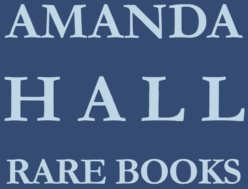Peter’s Letters to his Kinsfolk. The Second Edition. Volume the First [-Third]. Edinburgh, Blackwood, 1819.
First Edition. (though styled the second, as part of the satire). Three volumes, 8vo (217 x 128 mm), engraved portrait frontispiece to the first volume and pp. xv, [i], [v]-viii, 64, 61-333; viii, 363; ix, [i], 351, [1], [1] advertsisements, thirteen further engraved plates and one part-page illustration of a Glasgow steam-boat (III, 351), some offsetting and very occasional spotting, in contemporary russia, gilt and blind border to covers, spines gilt in compartments, lettered and numbered in gilt, marbled endpapers and edges, gilt dentelles, with the heraldic bookplate of Westport House (Co. Mayo) in each volume.
An excellent copy of Lockhart’s controversial portrayal of Scottish society, an entirely fictional correspondence which targeted many of the leading figures of the day. Presented as a series of letters from an imaginary Dr. Peter Morris - a portrait of whose dignified features stands as frontispiece to the first volume - to his kinsman in Wales, the Reverend David Williams, the work caused something of a scandal on publication. Among those who came in for Lockhart’s severest criticism were Leigh Hunt and William Hazlitt, who are condemned as ‘by far the vilest vermin that ever dared to creep upon the hem of the majestic garment of the English muse’.
‘In this work of epistolary fiction, Dr Peter Morris, a Welshman, travels to Scotland and connects with the important personages of the age. Penetrating and lively character sketches are the highlights of his letters to friends and relatives in Wales. As one of the most important chronicles of early nineteenth-century life in Scotland Peter's Letters can be seen as the 'biography of a culture' (Hart, 46, DNB)
Alongside the fictitious author and recipient, the whole presentation of Lockhart’s work is jocular, with its ‘Epistle Liminary to the Second Edition’, in which the author specifies minute instructions for the publishing of this ‘second’ edition as a joint venture between Cadell and Davies and William Blackwood: ‘The First Edition being but a coarse job, and so small withal, I did not think of him’ and wishing to discuss Peter’s Letters from Italy and Germany with the publisher. Another little bibliographical joke is the final page of advertisements in the third volume, giving an imaginary list of ‘Works by the Same Author’.
The text gives a detailed view of the Edinburgh of the day: the prominent men and women of the city, the clergy, the booksellers, the dandies; the courts, the coffee-rooms, the balls, dinner parties, dancing and social life; the university versus the English universities; the novels, the buildings, the ladies’ dress; the philosophers, the wits and the blue-stockings. ‘We can hardly be too grateful for so bold and skilful a picture of the social life of the age’ (J.H. Millar, A Literary History of Scotland, pp. 518-519). The writing capitalises on the intimacy of the letter form and no attempt is made to spare any of the dignitaries mentioned. Inevitably, Lockhart’s book caused more than its share of offence, ‘especially to the Whigs, by its personalities, and perhaps, as Scott said, by its truth’ (DNB).
CBEL 2189.
